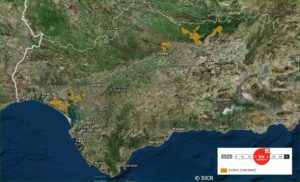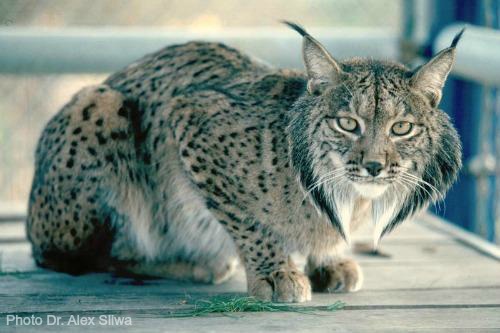- HB Length: 68-82 cm (27-32″)
- Tail Length: 12.5-15 cm (5-6″)
- Height: Appr. 60 cm (24″)
- Weight: 7-10 kg (15-22 lbs)
- Pop. Trend: Increasing
Iberian Lynx Lynx pardinus have a coat colour of yellowish to reddish-brown, patterned with many dark brown or black spots of varying size. There are three distinct individual coat patterns, and the belly fur is lightly coloured. They have the typical look of the lynx species, with a small head, flared facial ruff, long legs, dark ear tufts, and a very short, dark tipped tail. The facial ruff of adults is more distinct than that of other adult lynx species.
They are only about half the size of the Eurasian Lynx Lynx lynx. Males average about 27% larger than females. They are closer in size to the Canadian Lynx Lynx canadensis and the Bobcat Lynx rufus.
Distribution

Iberian lynx are found only in two small areas of southwest Spain on the Iberian Peninsula, west of the Pyrenees mountains. Despite extensive surveys, they have not been detected in Portugal since the 1990’s.
Closely related to the Eurasian Lynx, their ranges used to meet at the Spanish-French border along the Pyrenees Mountains. More recently, the range of the Iberian Lynx has significantly contracted, and now consists of a series of small islands of suitable natural habitat, such as national parks and reserves.
Home ranges in Donana National Park 9.5 km² for females, and 18.2 km² for males. Male territories overlap those of several females.
Habitat
The Iberian lynx lives in Mediterranean forests composed of native oaks and abundant undergrowth and thickets. It favours a mixture of dense scrub for shelter and open pasture for hunting. They are usually absent from cropland and exotic tree plantations (eucalyptus and pine) where rabbits are also scarce. In the Doñana National Park, the majority of resting spots of lynx during the day were located in thick heather scrub. Suitable breeding dens and water are important habitat features for the Iberian lynx.
Ecology
These cats prefer areas of native Mediterranean woodlands with native oaks and abundant undergrowth. More than 90% of daytime rest sites are in thick heather scrub. They move along the edges of meadows and more open grassland areas, especially around dusk and dawn, to hunt their main prey species, the European rabbit. Adult lynx require one rabbit per day, but females with kittens need three each day. 75-93% of their diet in Donana National Park is the European rabbit. Only when the rabbit population crashes due to viral outbreaks, do they look to other prey such as small rodents, birds, and the young of wild boar, red deer, fallow deer, and wild sheep. Leaves, soil and other debris are scraped over large kills to be consumed later.
Iberian Lynx show a great deal of seasonal and individual variation in activity levels. In summer they are nocturnal and crepuscular but in winter they are active during the daylight hours. Their overall activity patterns are closely synchronized with that of the rabbits.
Reproduction
Mating season runs from December to February. One to four, usually 2-3, kittens are born after a gestation period of 60-70 days. Females choose small cavities (rock caves, branch piles, dense bushes, hollow trees, etc.) as breeding dens. The peak birthing season is March and April in central and southern Spain. Kittens stay in the natal den for the first 20 days, after which their mother moves them to as many as three or four other dens. This may give them more room as they begin to develop their motor skills, as well as help protect them against being discovered by predators as fecal material and smells build up. It may also help avoid parasite build up in any single den. Kittens are eating solid food by 28 days but will nurse for 3-4 months becoming independent around 10 months of age.
Females with their own territory are able to breed at two years of age, but independent kittens often remain in their mother’s territory until 20 months of age. Males and females usually don’t breed until they acquire their own territory, and they may have to wait until a resident animal dies, or moves on. Iberian Lynx have lived to 13 years of age in the wild.
Threats
- habitat destruction and alteration due to agricultural and industrial development
- conversion of native Mediterranean forest to plantations with no undergrowth
- direct persecution
- killed by automobiles
- caught illegally or hunted with dogs
- killed in traps set for other predators
Conservation
The Iberian, or Spanish, Lynx is currently one of the most endangered wild cat species in the world. Between 1985 and 2001, their range declined by 87% and the number of breeding females dropped by more than 90%. By 2000, they existed in two small populations: 70-80 cats in the south of Andalusia and 170-180 individuals in the Sierra Morena.
Their numbers were decimated by rapid habitat loss, with scrublands converted to agriculture and pine and eucalyptus plantations. Human development such as dams, highways and railways also encroached on their native habitat.
While losing their habitat, humans were also over-hunting the cats main prey species, the European rabbit. When a disease called myxomatosis struck the remaining rabbits, the cat population dropped dramatically.
In 2002, a recovery program of captive breeding was initiated. Following the program’s implementation, the number of cubs soon exceeded the facilities’ capacity, and five more centers were opened to house the animals, including the first in Portugal in 2014.
The second aim of the project is working in the field, restoring habitat and increasing rabbit numbers with a view towards reintroduction. A specialist in both prey and habitat, the cat’s survival is intimately tied to the survival of their main prey species: the rabbit. Historically, rabbits were highly abundant on the Iberian peninsula. But after two viral illnesses in the 1900’s, rabbit numbers had dwindled by up to 90 percent. Whenever the rabbit population has grown significantly, another virus strain strikes back, reducing the number of prey animals for the cats.
The first lynx from the captive breeding project were reintroduced into a new area in Andalusia in 2009. Officials release captive-bred lynx in areas of appropriate habitat, rabbit abundance, and acceptance by the local human population. By 2019, the population in the wild was estimated to be 400 cats.
In 2015 the Iberian lynx was officially downgraded from Critically Endangered to Endangered. Although the species may not be completely secure yet, it has undoubtedly been brought back from almost certain extinction an in 2024 was classified as Vulnerable. Further action is still needed to save the Iberian lynx such as continuous effort to stimulate rabbit recovery, enhance habitat quality and connectivity, combat threats, and the restocking and release of lynx in new areas to connect populations. There is a need to implement recovery plans in all regions where the lynx once occurred over the past decades and to continue to carefully monitor the Iberian lynx as well as the conservation measures that are in place.
Compare this cat to the wide-ranging European Lynx.
Range map IUCN Red List (2015)
Updated 2020


42 Responses